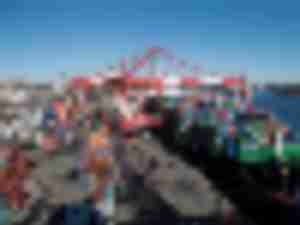New Montreal box terminal strongly spikes capacity
A new terminal in the Viau sector of the Port of Montreal inaugurated today, Friday Nov 18, boosts the port’s handling capacity by 350,000 TEUs as Canada’s second largest port after Vancouver positions itself for increased global trade with North Atlantic shipping a key target.
Just in time for Thanksgiving
The shipment of fresh and frozen produce is a billion dollar industry and ocean carriers take this commodity group very seriously.
Somalia, Trading in Oil and Piracy
Recent developments in Somalia may be a blessing or curse for international commerce as the nation enters a new age of exploration.
Tropical Shipping moving port operations from Saint John to Halifax
Significant developments are taking place these days at New Brunswick’s Port of Saint John on the Bay of Fundy.
The Gulf Courts Mega Shipping
The expansion of the Panama Canal has opened the Caribbean Basin and the Gulf of Mexico to the age of Mega Shipping. Increased commerce with Cuba, or a remix of cargo from regional load centers could spell a reshuffling of trade lanes to accommodate larger ships. Is the U.S. Gulf prepared for this potential traffic?
Nightmare Before Christmas
Let’s face it, Christmas is just around the corner. Yes, here in the Northeast the leaves are still turning, the nation is engaged in fall football and we just wrapped up the World Series. But, Thanksgiving is a few short weeks away and some stores are already selling Christmas ornaments. Santa is almost here!
Cuba Despierta – Cuba’s markets awaken
Cuba in the 40s and 50s was a playground for the rich and famous. The country’s economy was fueled by U.S. investment: some legal, some not so legal. A rich trade in coffee and tobacco found its way to America and the Cuban middle class imported everything from wearing apparel to washing machines. All that ended in 1959 when rebels under Fidel Castro tossed out Batista and threw Cuba into the dark ages.
Destination Latin America - Trans-loading East of Cristobal
Container ships exiting the Panama Canal either head into the Caribbean or make a sharp turn to starboard following the coast to load centers in Colombia, Venezuela and Trinidad. Ports along the upper coast of South America handle the bulk of “Hub and Spoke” traffic headed to neighboring countries as far south as Brazil.
U.S. and Canada: Loggerheads in the woods
It appears as though Canada and the U.S. are preparing for a trade war over softwood lumber exports. The U.S. and Canada have been long at loggerheads on the Canadian softwood exports to the U.S. and now that the one-year “standstill period” tacked onto the 2006 Canada-U.S. Softwood Lumber Agreement has expired, the chances for negotiating a timely agreement are dwindling.
Up for Grabs - Trans-loading in the Caribbean
Before its expansion, the Panama Canal was sending 4,500 TEU ships into the Caribbean with containers for trans-loading and final destination. Larger 8,500 TEU vessels transiting the Suez brought a little more volume to island hubs. Terminals in Jamaica and the Dominican Republic became trans-load centers for the Caribbean and US port range, while facilities in Colon could swing cargo to a wide range of destinations including South America.
© Copyright 1999–2025 American Journal of Transportation. All Rights Reserved










